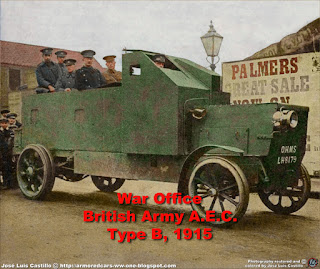Russian Oganesov Armored Cars. Two unknown prototypes of
1915.
I have made this "comparative composition"
respecting the full visibility of the magnificent drawings of M.M. Oganesov,
about his proposal, of two prototypes of armored cars, which I have called, in
the absence of being able to know the brand of the chassis on which they would
be built, Russian Oganesov Armored Cars (Prototypes of 1915). I want to add,
not without pride, that this is the first news that has been given about these
unknown Russian armored cars.
José Luis Castillo
P.S.- Apparently, M.M. Oganesov, in 1910, ran a car
dealership of the German brand "Dux", on Sadovaya Avenue, No. 17 of
Rostov. Did Oganesov think of the Dux chassis for the realization of his
prototypes?
xxxxxxxxxx
Coches Blindados rusos Oganesov . Dos prototipos desconocidos
de 1915.
He realizado esta
"composición comparativa" respetando la visibilidad íntegra de los
magníficos dibujos de M. M. Oganesov, sobre su propuesta de dos prototipos de
coches blindados, que he dado en llamar, a falta de poder conocer la marca del
chasis sobre el que se construirían, Coches Blindados rusos Oganesov
(Prototipos de 1915). Quiero añadir, no sin orgullo, que esta es la primera
noticia que se ha dado sobre estos desconocidos coches blindados rusos.
José Luis Castillo
P.S.- Al parecer,
M.M. Oganesov regentaba en 1910 un concesionario de automóviles de la marca
alemana "Dux", en la Avenida Sadovaya, Nº 17 de Rostov. ¿Penso
Oganesov en los chasis Dux para la realización de sus prototipos?.












